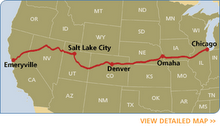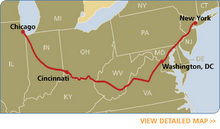
I left for Oakland’s Jack London Station at about 5:30 in the morning. As I rode to the station, I surprised to see that one or two more new condominium developments had been completed. I ride by this area on the freeway probably daily and yet the developments keep popping up before I realize – a sign of economic development or gentrification, depending upon how much money one has in one’s savings account or even if one has a saving account. The area which had once housed warehouses and storage facilities is now home to upscale lofts and soon-to-be upscale restaurants and stores. (When I ride through Alameda County, I will see that this is a theme, but more on that later.)
I arrived at the station about 30 minutes before departure and the evidence of early morning was still apparent. It was quiet and the fog still clung to the hills of Oakland and Berkeley behind me. In front of me, beyond the street and the newly developed luxury apartments was the estuary. Already a few boats were headed to the bay. The estuary shimmered and I felt cool enough in a sweater which was proof that it was going to be a beautiful day. I took pictures of the exterior and interior of the station, a building of glass and brick with graceful arches and a bronze statue of C.L. Dellums in front. Dellums was a regional vice-president of the BSCP and uncle of the city’s mayor, former Congressman Ron Dellums.
When I purchased my ticket from this station a few weeks ago, I knew that it was right that I start here. I knew when I saw the statue. It gave my trip a sense of symmetry and history.
The platform held only a few passengers, one couple and three of four people riding solo like me. No one spoke which is just as well. I hate people who like to talk in the morning and I was slowly and sadly acknowledging that I am a rotten photographer.

Freight trains rolled by tattooed with graffiti and I wonder if one day an archeologist will be able to identify where these cars traveled by the signs on their sides. I decided I need to take notes to keep track of my thoughts and so I’m scribbling random thoughts which I am now trying to decipher. I have no idea what I meant by boats sweating or colorful solitude but I am sure that when I thought it, it was brilliant.
Anyway, once on the train, I found riding through Oakland, Emeryville, and et al. to be full of contrasts. Everything I see is familiar but I see it from a different angle. I realize that the passenger cars and freight cars ride the same rails so it seems that I am riding through the city’s seams. On the right, we pass trucks, freight cars, abandoned buildings that look like punch-drunk fighters with broken windows and collapsing rooftops. On the left is the Bay, and because the sun is still rising, it has that strange iridescence that only water has. It is blue, silver, pink and orange. Near Richmond, the shoreline is peppered with old tires. Beyond that, we pass the various islands – Treasure, Alcatraz and bridges -- the Bay and Golden Gate in the distance and others so much closer I can see the rivets.
I realize that over here are the nice office buildings with landscaped lawns and beautiful facades and on the other side of rusting fences are factories, parking lots, and men and women bringing to us the stuff that creates our life – what we eat, use to build, use to live. This is the backstage of a play, watching all the machinery and mechanisms that help to create the drama that we see and where the technicians, stage hands, costumers and make-up artists do all the work that we don’t see. This is how our stuff gets to us and it’s not pretty; it’s chaotic and messy.
The garbage that we discarded accumulates at the foot of those fences, out of sight. People live in and around it. I see their tents, tarps and shopping carts and beyond it, over the fence another condominium being built, with marigold and terracotta trim. Here you can see what cities aspire to be and what they seek to hide.
(Non-sequitar – I see an analogy being drawn between what I see and the work of the porters, who, I suppose like all people in the service sector, must never shown you how hard the work actually is or in the case of the porters, the indignities they were forced to endure.)
I am now having a private and unofficial graffiti contest and I am the sole judge. Berkeley is in the lead so far with its moving image of a DJ spinning on two turntables and Reno is in second with its imaginative use of color in tagging.





No comments:
Post a Comment
Post a comment. Thank you.